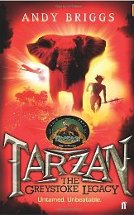Tarzan : the Greystoke legacy by Andy Briggs

Faber, 2011. ISBN 978 0 571272389.
Andy Briggs' contemporary Tarzan story shows a great deal of loyalty to
the vision and style of Edgar Rice Burroughs. The original Tarzan
of
the apes was published nearly one hundred years ago, yet one is
immediately aware when reading this new episode that very little change
was necessary in the setting. The early Tarzan was way ahead of his
time in recognising and resisting the threat posed by European
exploitation of Africa's rain forests. Today jungles are being cleared
and animals threatened at an alarming rate, hence it is natural that
Briggs calls upon this true eco warrior to defend his animal friends in
the same valiant tradition.
Briggs establishes Tarzan in modern times with the death of his wealthy
parents in an air crash in the Congo whilst striving to protect the
ecology of the region. Tarzan is then raised by a band of gorillas with
whom he establishes bonds and rudimentary communication.
The character Jane finds herself in the forbidding jungle when her
financially desperate father organises an illegal logging operation.
This in itself enrages Tarzan, but so too does the presence of greater
threats from local poachers and heavily armed warlords who have fled
neighbouring Rwanda.
The inclusion of these plausible and realistic elements enabled Briggs
to create a story with some depth which will educate young readers
concerning the environmental destruction, social problems and political
upheaval within the region.
Whilst the narrative appeared to labour in the first few chapters, the
story gathers pace as the various characters and groups interact. The
hero Tarzan must apply ingenuity, strength, courage and animal
communication to defeat the most evil of enemies and for the purpose of
the narrative, the despoliation of the forest by loggers is considered
a lesser threat. Whilst protecting Jane from a range of hazards, Tarzan
is able to educate her regarding the environmental impact of her
father's timber operation. This contrasts with his ferocious attacks
upon the armed brigands and the reader is made aware of Tarzan's innate
intelligence compared with Jane's intellectual development prompted by
her exposure to ecology and experience with him.
Like many adventure tales, the reader must forgive certain details,
such as a flimsy construct which explains why Tarzan can speak basic
English and his super-human demonstrations of physical strength and
athleticism. This story does have substance, offering valuable insights
on various topics regarding a continent of which many young people will
have limited knowledge. Readers will be captivated by the Tarzan
character as so many have in the past and will be enlightened whilst
being entertained.
Rob Welsh